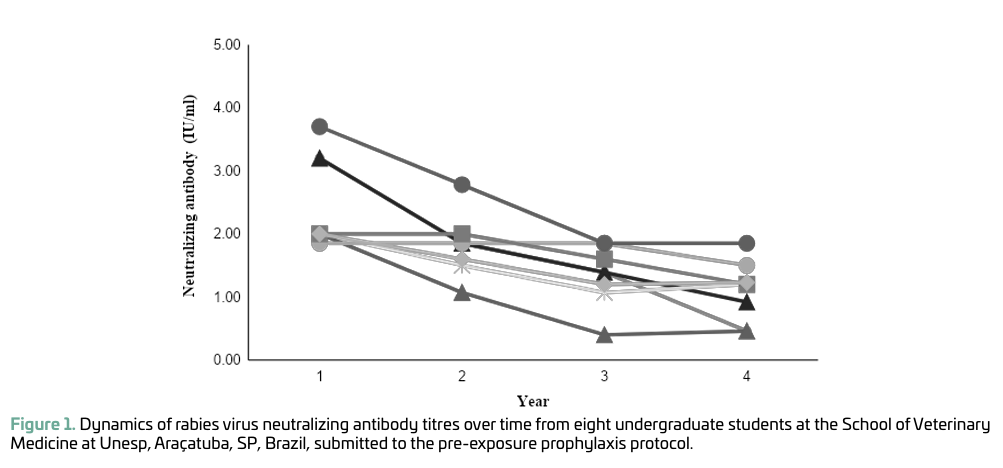Dynamics of virus-neutralizing IgG antibody titres in veterinary students submitted to rabies pre-exposure prophylaxis
DOI:
https://doi.org/10.21708/avb.2024.18.4.12573Resumo
Rabies is a viral disease distributed worldwide, characterized by an acute and almost invariably fatal encephalitis. Pre-exposure prophylaxis (PrEP) is a protective measure for individuals continuously exposed to the risk of infection such as veterinary students and practitioners. The objective of this study was to evaluate the frequency with which the students perform the PrEP, to evaluate the protection they presented as well as the dynamics of the neutralizing IgG antibodies response. A retrospective study was carried out with data from the archives of the Epidemiological Surveillance Service of the Health Department of the Araçatuba Municipality, spanning the period between 2000 and 2017. A total of 2,404 records were evaluated, 86.4% of which presented protective titers against rabies (≥0.5 IU/mL). The records comprised 875 individuals who performed the titration of neutralizing antibodies (IgG). Adhesion of the undergraduate students to PrEP in the year they were admitted was 85%. The mixed linear model used showed a mean annual decrease of the neutralizing antibody titre of 15.1 ± 4.3% (p=3.86 x 10-4) after the last dose of vaccine. There was no significant difference of the antibody titres between individuals who received one, two or three doses of vaccine (P>0.05), nor between males and females. Although PrEP had good adhesion by the incoming students and was efficient in generating neutralizing antibodies against rabies, titres decreased over time, reinforcing the need of performing antibody titration at least every two years to check for the necessity of a booster vaccination.
Downloads

Downloads
Publicado
Edição
Seção
Licença
Copyright (c) 2024 Acta Veterinaria Brasilica

Este trabalho está licenciado sob uma licença Creative Commons Attribution 4.0 International License.
Autores que publicam na Acta Veterinaria Brasilica concordam com os seguintes termos: a) Autores mantém os direitos autorais e concedem à revista o direito de primeira publicação, com o trabalho simultaneamente licenciado sob a Licença Creative Commons Attribution que permite o compartilhamento do trabalho com reconhecimento da autoria e publicação inicial nesta revista. b) Autores têm autorização para assumir contratos adicionais separadamente, para distribuição não-exclusiva da versão do trabalho publicada nesta revista (ex.: publicar em repositório institucional ou como capítulo de livro), com reconhecimento de autoria e publicação inicial nesta revista. c) Autores têm permissão e são estimulados a publicar e distribuir seu trabalho online (ex.: em repositórios institucionais ou na sua página pessoal) a qualquer ponto antes ou durante o processo editorial, já que isso pode gerar alterações produtivas, bem como aumentar o impacto e a citação do trabalho publicado (Veja O Efeito do Acesso Livre).


 Esta obra está licenciada com uma Licença
Esta obra está licenciada com uma Licença 